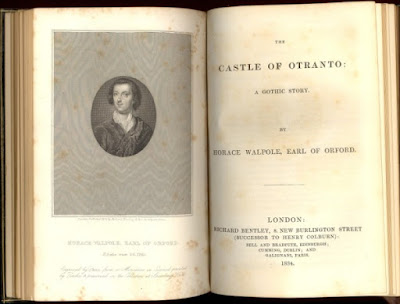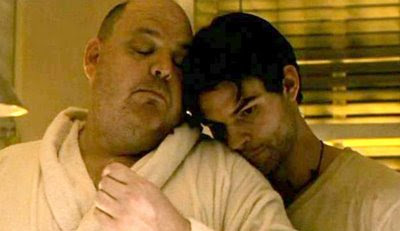Spine-tingling Horror Reads
I was asked by the Vault of Horror’s B-sol to contribute to the mega list of horror fiction awhile back. Through some weird alchemic ritual, B-sol finds the most popular picks from contributions by the Cyber-Horror Elite to compose his compendium of horror fiction. Here are the picks I submitted and my geeky reasons why.
 The Castle of Otranto
The Castle of Otranto
Horace Walpole’s Ortanto is the one piece of literature that kickstarts the entire Gothic genre. It chronicles the story of Manfred, a gothic anti-hero who pursues Isabella, the fiancé of his son Conrad. After Conrad is crushed to death by a giant helmet, chase scenes through spooky castles and damp catacombs ensue.
 Frankenstein
Frankenstein
How could I call myself a monster scholar and not pick one of the seminal texts of monster literature? What continues to fascinate me about Shelley’s text are the differences between the 1818 and 1831 versions. In the 1818 edition Shelley is much less forgiving of Frankenstein’s dabbling with the stuff of life, while in the 1831 edition (published after her husband Percy Shelley passed away) is more permissive of Victor’s hijinks.
 Dracula
Dracula
Building on the work of his predecessors in vampire fiction, Stoker creates the vampire as a symbol of sexual perversion, reverse colonization and xenophobia. But Stoker’s depiction of the vampire might also have been drawn from real life. Stoker worked as the manger for the Lyceum theater, owned by actor Henry Irving. The relationship soured soon after it began and Irving died in 1905, leaving Stoker nearly penniless. Looking at Irving’s face it’s hard not to draw a parallel to Stoker’s vampire, as his looks mimic the “high aquiline nose” and long face of the nosferatu.
 Carmilla
Carmilla
The first lesbian vampire tale, Le Fanu’s story had a strong impact on Bram Stoker. In an excised chapter from Stoker’s novel (published after his death by his widow) Harker stumbles upon the crypt of the countess Mircalla (an anagram of Carmilla) on his way to Dracula’s castle. Carmilla preys on the innocent and naïve Laura, sucking the life out of her companion with her special brand of “strange love”
 I Am Legend
I Am Legend
Matheson’s tale pits one surviving human against a world of vampires. I Am Legend is one of the best pieces of vampire fiction in recent memory and has been the subject of various film adaptations (Omega Man and I Am Legend).
 The Monk
The Monk
A reaction to the Gothic tales of Anne Radcliffe, the Monk was written by a member of British parliament and its scandalous content nearly ended his career. It tells the story of Ambrosio, a sanctimonious monk whose fall from grace is precipitated by the discovery that one of his fellow monks is a woman in disguise. What follows is Ambrosio’s journey down a path of debauchery and sin which ends in the rape and murder of his sister Antonia.
 Varney the Vampire
Varney the Vampire
Varney the Vampire was born in a series of penny dreadfuls about the exploits of Sir Francis Varney, a vampire that plagues the Bannerworth family with his efforts to sink his fangs into the youngest daughter, Flora. Poor Varney was killed off in a number of the serials, only to rise once again and continue the rampant success of his pamphlets.
 Poe’s Collected Works
Poe’s Collected Works
The master of psychological horror, Poe’s collected works are a must read for anyone calling themselves a horror fan. Poe’s stories have been the basis for hundreds of films, most notably the adaptations done by Vincent Price at RKO. For more thrills and chills check out Poe’s short story Berenice, about a monomaniac obsessed with the teeth of his cataleptic fiancé.
 American Psycho
American Psycho
Bret Ellis melds satire and the psychological thriller in this critique of 1980s yuppie culture. The book gives the reader a peek into the life of Patrick Batemen, a wealthy investment banker who enjoys a secret life of murder and torture . The book’s description of Batemen’s murders and mutilations are much more violent than what is depicted in the film version and the book has long been a source of controversy for its depiction of violence against women.
 The Castle of Otranto
The Castle of OtrantoHorace Walpole’s Ortanto is the one piece of literature that kickstarts the entire Gothic genre. It chronicles the story of Manfred, a gothic anti-hero who pursues Isabella, the fiancé of his son Conrad. After Conrad is crushed to death by a giant helmet, chase scenes through spooky castles and damp catacombs ensue.
 Frankenstein
Frankenstein How could I call myself a monster scholar and not pick one of the seminal texts of monster literature? What continues to fascinate me about Shelley’s text are the differences between the 1818 and 1831 versions. In the 1818 edition Shelley is much less forgiving of Frankenstein’s dabbling with the stuff of life, while in the 1831 edition (published after her husband Percy Shelley passed away) is more permissive of Victor’s hijinks.
 Dracula
DraculaBuilding on the work of his predecessors in vampire fiction, Stoker creates the vampire as a symbol of sexual perversion, reverse colonization and xenophobia. But Stoker’s depiction of the vampire might also have been drawn from real life. Stoker worked as the manger for the Lyceum theater, owned by actor Henry Irving. The relationship soured soon after it began and Irving died in 1905, leaving Stoker nearly penniless. Looking at Irving’s face it’s hard not to draw a parallel to Stoker’s vampire, as his looks mimic the “high aquiline nose” and long face of the nosferatu.
 Carmilla
CarmillaThe first lesbian vampire tale, Le Fanu’s story had a strong impact on Bram Stoker. In an excised chapter from Stoker’s novel (published after his death by his widow) Harker stumbles upon the crypt of the countess Mircalla (an anagram of Carmilla) on his way to Dracula’s castle. Carmilla preys on the innocent and naïve Laura, sucking the life out of her companion with her special brand of “strange love”
 I Am Legend
I Am LegendMatheson’s tale pits one surviving human against a world of vampires. I Am Legend is one of the best pieces of vampire fiction in recent memory and has been the subject of various film adaptations (Omega Man and I Am Legend).
 The Monk
The MonkA reaction to the Gothic tales of Anne Radcliffe, the Monk was written by a member of British parliament and its scandalous content nearly ended his career. It tells the story of Ambrosio, a sanctimonious monk whose fall from grace is precipitated by the discovery that one of his fellow monks is a woman in disguise. What follows is Ambrosio’s journey down a path of debauchery and sin which ends in the rape and murder of his sister Antonia.
 Varney the Vampire
Varney the VampireVarney the Vampire was born in a series of penny dreadfuls about the exploits of Sir Francis Varney, a vampire that plagues the Bannerworth family with his efforts to sink his fangs into the youngest daughter, Flora. Poor Varney was killed off in a number of the serials, only to rise once again and continue the rampant success of his pamphlets.
 Poe’s Collected Works
Poe’s Collected WorksThe master of psychological horror, Poe’s collected works are a must read for anyone calling themselves a horror fan. Poe’s stories have been the basis for hundreds of films, most notably the adaptations done by Vincent Price at RKO. For more thrills and chills check out Poe’s short story Berenice, about a monomaniac obsessed with the teeth of his cataleptic fiancé.
 American Psycho
American PsychoBret Ellis melds satire and the psychological thriller in this critique of 1980s yuppie culture. The book gives the reader a peek into the life of Patrick Batemen, a wealthy investment banker who enjoys a secret life of murder and torture . The book’s description of Batemen’s murders and mutilations are much more violent than what is depicted in the film version and the book has long been a source of controversy for its depiction of violence against women.



Comments
Post a Comment